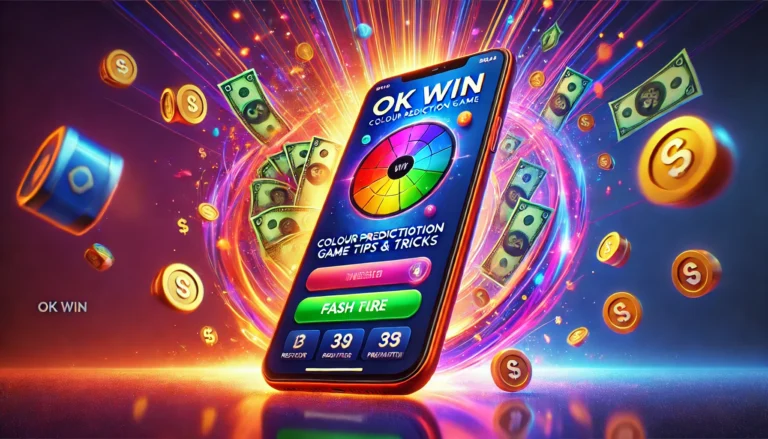The Role of Winning Real Money in Online Color Prediction Games

Real-money contributes significantly to online color prediction games as it enables players to analyze patterns, probability, and results. Concepts such as probability theory and statistics enable players to recognize patterns in color strings and make calculated decisions. Most players use models based on math to follow past results and forecast the future based on those, which enhances chances of success. Although the games are based on randomness, analyzing patterns in numbers as well as probability distribution will aid decision-making. Reason and strategic calculations can increase fun in the gameplay as players make use of Real-money expertise and apply it as a tool for enhanced performance.
Understanding Probability in Color Prediction Games
Probability forms the foundation of color prediction games. It assists players in making an estimation on the chances of a color occurring in the next round. All events in color prediction games have a probability distribution, which can be used to calculate the optimal possible decisions. For example, if a game features three colors, namely, red, green, and violet, with each color equally likely to appear, the probability for guessing the correct color in an unbiased game would be 1/3 or a ratio of 33.33%. Yet, some games create some variations that slightly alter such probabilities, making math calculations even more significant. Platforms like Club 91 integrate probability models to enhance player engagement and strategy, demonstrating the importance of real-money insights in predicting outcomes.
Statistical Analysis and Pattern Recognition
Most experienced players apply statistical methods to chart the results over time. By tracking the pattern of colors and graphing the frequency at which each color appears, they try to discover patterns or trends that could provide them with an edge.
For instance, If the color red appeared five consecutive times, would that make it more likely that it would change in the next round?
Are some colors more likely to occur more often at a particular interval?
Although color prediction games are based on randomness, tracking statistically assists the players in identifying if some trends are developing across several rounds.
Real-money Models for Prediction
Players utilize different Real-money models to enhance their decision-making system. Some of the most well-known among these are:
1. Probability Trees
A probability tree is a diagram used to depict all potential outcomes for a series of events. It is employed by players so they can visualize how each decision impacts the probability of a given outcome.
Plants- If the last two rounds had a red appearance, a probability tree can demonstrate the probability that the next color will be red, green, or violet, based on past trends.
2. Markov Chains
A Markov Chain is a system that changes from one state to another according to definite probabilities. A Markov Chain is especially helpful in games when the past events may shape future events.
If a game takes a pattern in which red appears after green 70% of the time, a Markov chain can be used to model these changes and advise decision-making.
3. Regression Analysis
Regression analysis would be employed to identify correlations among various variables. In color prediction games, players may examine past information and try to determine if some variables have an impact on the result of the next round.
The Law of Large Numbers
The Law of Large Numbers tells us that the more trials one does, the more the actual probability of the event occurring approaches the expected probability. What this means is that the short-term random variations will lead to unpredictable outcomes, but over time, the probabilities will even out.
For example, although a game might be programmed so that every color will appear equally frequently, one color will still be seen more often in the short run. Still, if the game covers thousands of rounds, each color will appear around one-third of the time. This maxim assists players in being patient and recognizing that randomness averages itself out over the long run. Platforms like 91 club game emphasize the importance of statistical balance, allowing players to develop better strategies based on probability and long-term trends.
Randomness and the Gaming Fallacy
One of the largest errors committed by players is the GamingFallacy—the assumption that past events have an impact on future conditions in a system that’s random. For instance:
If green hasn’t shown up after ten rounds, players tend to think that it “ought” to reappear shortly. But in an impartially determined game, each round is still equally random, past performance not influencing future performance
Most color prediction games on the internet are driven by random number generators (RNGs). RNGs make sure that the results are fair and unpredictable. Sequences are created by an RNG that mimics randomness so that things can never be predicted with absolute certainty.
Some platforms provide a provably fair system, where players can verify the fairness of results using cryptographic techniques. This ensures transparency and reinforces trust in the game’s Real-money foundation.
Game Theory and Decision-Making
Game theory is another branch of math that has a significant application in color prediction games. It assists players in making strategic choices by comparing possible actions with the possible results.
Many color prediction games utilize the following common concepts in game theory:
Expected Value (EV): It determines the average result of a decision in the long run.
Risk Management: Real-money all models are used by players in deciding when to play forcefully and when to play conservatively.
Mixed Strategies: In contrast with using one strategy, players can employ a combination of strategies that they can use in different circumstances.
How can one use math in gameplay
If you wish to use math effectively in color prediction games, the following are the steps you can take:
- Track and analyze data
- Track previously experienced color results and search for patterns.
- Analyze with spreadsheets, especially using specialized programs.
- Understand the likelihood of each outcome
- Know the concept and application of probability with regard to various game settings.
- Make Logical Choices
- Do not make decisions based on emotions.
- Depending on data analysis and probability instead of assumption.
- Remain Committed
- Realize that Real-moneys can direct decisions but never promise outcomes.
- Be patient and play with a long-term vision.
- Verify Game Fairness
Select platforms with verifiable random number generators (RNGs) and a focus on transparency.
Conclusion
Real-money reasoning forms the foundation for color prediction games, influencing anything from probability and statistical analysis to decision-making and game theory. Luck plays a part, but the use of Real-money reasoning can enhance logical decision-making and strategic planning. With an understanding of probability, data analysis, and the avoidance of the gaming fallacy, players will be able to make intelligent decisions and enjoy a more rewarding gaming experience. As much as possible, no tool can provide a 100% accurate forecast, but platforms like Club 91 offer strategic insights and structured gameplay, helping players develop a more disciplined and analytical playing style.
